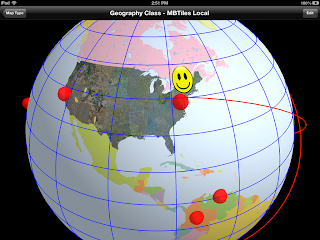They do add a bit of complexity, though, because of the way my project works.
Who Owns The Code?
That's easy, I own the code. Every line of WhirlyGlobe-Maply is MINE! But don't worry, you can use it for free.
Copyright is separate from license (I can hear my lawyer frowning). I hold the copyright on the code, but I release it under an Apache 2.0 license so you can use it. That license is incredibly friendly to commercial interests so you can make apps, modify the source, and generally go wild while abiding by its pleasant terms.
Sometimes I put WhirlyGlobe-Maply under another license for a client. Why? Money, that's why. This doesn't effect the Apache 2.0 version and you needn't worry about it. But it does mean I must own every line of WhirlyGlobe-Maply.
This is Open Source?
It is, yes, one of the variants. It's not GPL, it's not even one of those big techno-hippie projects we all love. But it is a well known, well tested, well understood variety of open source.
Okay, so if I own it, can I take it away? I cannot. Even if I decide to start charging for WhirlyGlobe-Maply 3.0 you still have the 2.2 version released under the Apache 2.0 license. That can never go away. [I have no plans to do this, by the way.]
Git Pull and Contributed Source
Now we get to the point of this post. When contributors send me a pull request, what's the copyright on it? Legally, it's "All Rights Reserved".
This won't do for either the open source version or for my own. It could potentially taint the apps of anyone who uses the toolkit. I can't have that.
If you're sending me a pull request, I need you to resolve the copyright and ownership.
Copyright Options
If you've modified the source, those modifications are yours (or your employer's). If you write something new, that source is yours (or your employer's). It's up to you (or your employer) to assign the copyright. I'll explain some options.
All Rights Reserved
If you reserve copyright I can't touch it. You can do what you like with it, including putting it up on github, but I'd ask you to put an explicit copyright on it so no one gets confused.If you modified my source code in the process, you can't change my Apache 2.0 license and the copyright is now ambiguous, in my mind at least. It would be great if you put a notice to that effect at the top of the files you've changed. That way no one will accidentally get into trouble.
In any case, I won't be putting any of this code in my github repo.
Retain Ownership & Assign an Open Source License
If you write brand new code, you could retain ownership for yourself, of course. If you then put an open source license on it, I will be delighted to put it in the Contributed directory. Please pick a really, really permissive license, if you would.I don't own source code in the Contributed area of WhirlyGlobe-Maply. I may maintain it, from time to time, but I make no guarantees.
If you want to modify code in Contributed, feel free. Just respect the license that's on it.
Transfer Ownership
The last option is transferring ownership to mousebird consulting inc (e.g. me). In this case I'll pull it back into the toolkit, slap the Apache 2.0 license on it and treat it as my own, because it now is my own.I'm only going to ask this for small amounts of code and bug fixes. I know, it seems stupid to ask for bug fixes, but I legally have to.
Let me emphasize: YOU DO NOT HAVE TO DO THIS. Sending me a pull request does not imply anything. When I ask you, you can then make your choice and I will respect it.
Working For The Man
If you're an employee or doing work for hire, you must get your employer's permission to assign ownership. I cannot accept the assignment if I think you can't give it, so I may ask some probing questions.
I know no one does this and I'm sorry to be difficult. Look, I've been in silicon valley a long time now and I've seen a lot of stupid go by. Much as I love github, and I really do, there is a lot of stupid around it and copyright. I won't have it on my project.
"But hey", you may be thinking, "don't you work for The Man as well!" I do, random interlocutor, but I have a Lawyer and a Contract. It's a big nasty contract that spells out what I own and what The Man owns. I trust it works because it's killed a few potential deals.
Standard work for hire contracts or employment agreements do not look like mine. I very much doubt you have the same rights I do unless you specifically negotiated for them.
Conclusion
If I've sent you here for a pull request, let me just say: Thank You! Even if I can't accept it, it's helpful for a few reasons:
- I can see what developers are interested in
- If it's a bug fix, I can see what the problem is
- It gets my stats up on github (don't laugh)
- It was probably useful in your own app
So again, thank you!
Please take a look at your copyright options and pick the one most appropriate. Picking nothing defaults to "All Rights Reserved". That's fine too.





